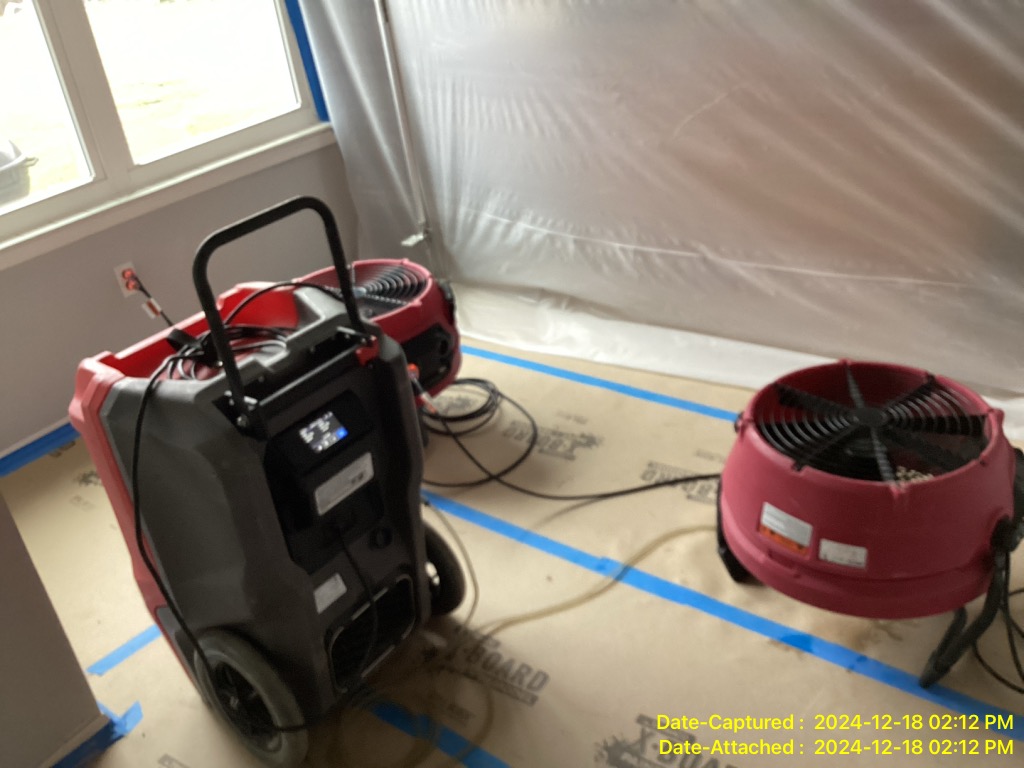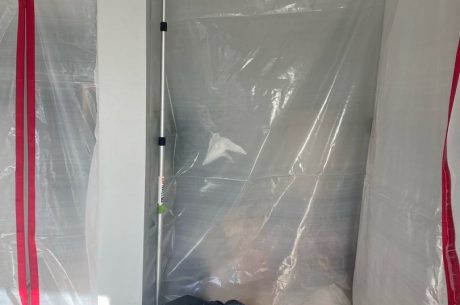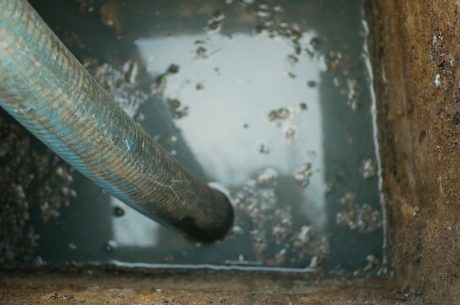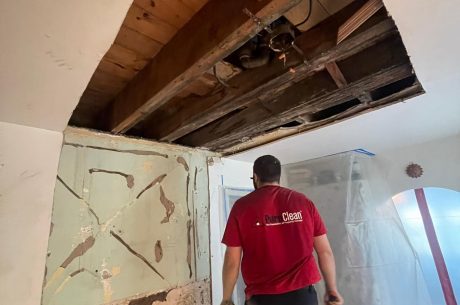Table of Contents
Hidden water damage represents one of the most significant threats to Norristown homeowners, with the potential for extensive property damage and serious health consequences.
However, through understanding warning signs, implementing systematic detection methods, and maintaining proactive prevention strategies, homeowners can effectively protect their investments and families.
Water damage is a silent destroyer that affects thousands of homes across Pennsylvania every year, and Norristown residents are no exception.
With its mix of historic homes and modern developments, this Montgomery County community faces unique challenges when it comes to detecting and addressing hidden water damage.
Understanding the warning signs and taking proactive measures can save homeowners thousands of dollars and protect their most valuable investment.
Damage in Norristown
Norristown, with its current population of approximately 35,782 residents and median household income of $65,058, represents a diverse suburban community where water damage prevention is crucial for both homeowners and renters.
The area’s housing stock includes a mix of property values, with an estimated median house value of $222,663 as of 2023.
Statistics show that just over 20 percent of Americans need water-related damage restoration each year, making it one of the most common homeowner challenges.
The financial impact is substantial. According to data collected from 2017 to 2021, the average U.S. household claim for water damage and freezing was $12,514, while more recent data suggests the average insurance claim to repair water damage is $11,605.
For Norristown homeowners, where property values vary significantly across different neighborhoods, repair costs can range from moderate to substantial depending on the specific area and type of housing.
Water Damage Statistics Overview
| Statistic | Value | Source Period |
|---|---|---|
| Homes affected annually | 20% of American households | 2024 |
| Average insurance claim cost | $12,514 | 2017-2021 |
| Updated average claim cost | $11,605 | 2024 |
| Daily water damage incidents | 14,000 nationwide | 2025 |
| Homes filing claims yearly | 1.6% of insured homes | 2025 |
| Norristown population | 35,782 residents | 2023 |
| Median household income | $65,058 | 2023 |
| Median home value | $222,663 | 2023 |
| Estimated households at risk | ~2,900 households annually* | 2025 |
| Potential economic impact | $33.7M annually** | 2025 |
Based on 20% of approximately 14,500 households in Norristown Estimated based on average claim costs and at-risk households
About 25% of home insurance claims filed from 2018 to 2022 were due to water damage or freezing, second only to wind or hail damage, highlighting the prevalence of this issue across the United States.
Understanding Norristown’s Unique Risk Factors
Norristown’s geographic location and housing characteristics create specific vulnerabilities to water damage.
The community’s position along the Schuylkill River, approximately 6 miles from Philadelphia, combined with Pennsylvania’s variable climate patterns, creates multiple risk factors that residents must understand.
The area’s diverse housing stock, ranging from historic properties to modern developments, presents varying levels of vulnerability to water intrusion.
Norristown’s older residential areas, some with housing dating back over a century, face particular challenges with aging infrastructure including:
- Deteriorating plumbing systems in older homes
- Foundation settling and potential basement flooding
- Outdated drainage systems that may not handle modern precipitation patterns
- Proximity to the Schuylkill River creating flood risk potential
The community’s urban density and mixed residential-commercial areas can also contribute to drainage challenges during heavy rainfall events.
Additionally, the area’s mature tree canopy, while providing environmental benefits, can create additional risks through root intrusion into sewer lines and foundation damage during severe weather events.
Norristown-Specific Considerations
Given Norristown’s demographic diversity and range of housing types, water damage prevention strategies should account for:
- Rental Properties: With a significant portion of residents being renters, understanding tenant rights and landlord responsibilities for water damage is crucial
- Income Variability: The median household income of $65,058 means that unexpected water damage costs can be particularly burdensome for many families
- Housing Age Diversity: Properties range from historic homes requiring specialized attention to newer constructions with modern systems
- Geographic Risk: Proximity to the Schuylkill River and location in Montgomery County’s drainage patterns requires awareness of flood risks and proper insurance coverage
Economic Impact Analysis
For Norristown’s approximately 14,500 households, the annual economic impact of water damage is significant:
- Low-end estimate: If only 10% of households experience water damage annually, with average costs of $8,000, the community impact would be $11.6 million
- Moderate estimate: At the national average of 20% of households, using the current average claim cost of $11,605, the annual impact reaches approximately $33.7 million
- High-end estimate: During severe weather years or infrastructure failures, costs could exceed $40 million community-wide
These figures highlight the importance of proactive water damage prevention and the significant financial burden that water damage places on the Norristown community as a whole.
Climate-Related Risk Factors
Pennsylvania’s climate presents several challenges for water damage prevention. The state experiences significant seasonal temperature variations, freeze-thaw cycles that can damage pipes and foundations, and periodic severe weather events including heavy rainfall and occasional flooding.
These conditions create perfect scenarios for both immediate water damage and the slow, insidious type of hidden damage that can go undetected for months or years.
Early Warning Signs of Hidden Water Damage
Detecting hidden water damage requires vigilance and understanding of subtle indicators that many homeowners overlook.
Unlike obvious flooding or burst pipes, hidden water damage develops gradually, often behind walls, under floors, or in other concealed areas where it can cause extensive structural damage before becoming apparent.
Visual Indicators
Discoloration and Staining: One of the most common early signs is unexplained discoloration on walls, ceilings, or floors.
Water stains often appear as yellowish-brown rings or patches that may seem to appear and disappear depending on moisture levels. These stains frequently occur around windows, near plumbing fixtures, or on ceilings below bathrooms or kitchens.
Paint and Wallpaper Anomalies: Hidden moisture causes paint to bubble, crack, or peel in unusual patterns. Wallpaper may begin to curl at edges or develop bubbles and wrinkles. These changes often occur gradually, making them easy to dismiss as normal wear until the damage becomes extensive.
Warped or Buckled Flooring: Wood floors may begin to cup, crown, or separate at joints when exposed to hidden moisture. Laminate flooring might lift at edges or develop a spongy feel underfoot. Even tile floors can show signs through loose tiles or cracked grout lines.
Sensory Clues
Musty Odors: Perhaps the most reliable early indicator of hidden water damage is a persistent musty or earthy smell that doesn’t dissipate with normal cleaning or ventilation.
This odor typically indicates mold or mildew growth in hidden areas and should never be ignored.
Unusual Sounds: Hidden water damage can create subtle audio cues including dripping sounds within walls, running water sounds when no fixtures are in use, or creaking and settling noises as building materials respond to moisture changes.
Temperature Variations: Areas affected by hidden water damage may feel unusually cold or damp to the touch. Walls or floors that seem consistently cooler than surrounding areas may indicate moisture infiltration.
Environmental Changes
Increased Humidity: If certain rooms consistently feel more humid than others, or if windows frequently fog up without obvious causes, hidden moisture sources may be the culprit.
Pest Activity: Increased insect activity, particularly from moisture-loving pests like silverfish, termites, or certain types of beetles, can indicate hidden water problems. These creatures are attracted to the damp conditions created by concealed leaks.
Common Sources of Hidden Water Damage in Norristown Homes
Understanding where hidden water damage typically originates helps homeowners focus their inspection efforts and implement preventive measures. Norristown’s housing stock, ranging from historic properties to modern constructions, presents diverse vulnerability points.
Plumbing-Related Sources
Supply Line Failures: Copper pipes common in older Norristown homes can develop pinhole leaks that spray small amounts of water over extended periods. These leaks often occur behind walls or in crawl spaces where they remain undetected until significant damage occurs.
Fixture Connections: Toilets, sinks, and appliance connections frequently develop slow leaks at connection points. A toilet that rocks slightly or a sink that seems loose may indicate seal failure and hidden water intrusion.
Drainage Issues: Slow drains can cause water to back up and seep into surrounding structures. This is particularly problematic in older homes where drainage systems may not meet current capacity demands.
Structural Vulnerabilities
Foundation Issues: Norristown’s varied soil conditions can lead to foundation settling or cracking, creating pathways for water infiltration. Hydrostatic pressure from groundwater can force moisture through even small foundation imperfections.
Roof and Attic Problems: Missing or damaged shingles, compromised flashing around chimneys or vents, and ice dam formation during winter months can allow water to enter roof structures and travel significant distances before becoming visible.
Window and Door Seals: Degraded caulking and weatherstripping around windows and doors create entry points for wind-driven rain. Over time, this moisture can penetrate wall cavities and cause extensive hidden damage.
HVAC System Complications
Condensation Issues: Air conditioning systems and ductwork can generate significant condensation, particularly in humid summer months. Poorly insulated or damaged ductwork can allow this moisture to accumulate in wall cavities or above ceilings.
Drainage Problems: HVAC condensate drains can become clogged or disconnected, causing water to accumulate in mechanical spaces or drain pans that homeowners rarely inspect.
Detection Methods and Tools
Effective detection of hidden water damage requires systematic approaches and, in many cases, specialized equipment. Norristown homeowners can employ various methods ranging from simple visual inspections to professional-grade detection tools.
DIY Detection Techniques
Monthly Walk-Through Inspections: Establish a routine monthly inspection schedule focusing on high-risk areas including basements, crawl spaces, attics, and areas around plumbing fixtures. Look for any changes from previous inspections, no matter how minor.
Water Meter Monitoring: Learn to read your water meter and check it periodically when no water is being used in the home. Any movement of the meter dial during these periods indicates a leak somewhere in the system.
Utility Bill Analysis: Unexplained increases in water bills can indicate hidden leaks. Track monthly usage patterns and investigate any significant deviations from historical norms.
Professional Detection Equipment
Moisture Meters: These devices can detect elevated moisture levels in building materials without destructive testing. Professional-grade meters can identify problem areas that visual inspection might miss.
Thermal Imaging: Infrared cameras can reveal temperature differences that indicate moisture intrusion, insulation problems, or active leaks behind walls and in other concealed areas.
Acoustic Detection: Specialized listening devices can identify the sound of water movement within walls or underground, helping pinpoint leak locations without excavation.
The Norristown Climate Factor
Norristown’s specific climate conditions create unique challenges for water damage prevention and detection. Understanding these local factors helps homeowners prepare for seasonal risks and implement appropriate preventive measures.
Seasonal Patterns
Winter Challenges: Pennsylvania winters bring freeze-thaw cycles that can burst pipes, damage foundations, and create ice dams on roofs. The transition from heating season to spring thaw often reveals winter-related water damage that developed during cold months.
Spring Vulnerabilities: Rapid snowmelt combined with spring rains can overwhelm drainage systems and create hydrostatic pressure against foundations. This is often when hidden winter damage becomes apparent.
Summer Concerns: High humidity levels can exacerbate existing moisture problems and create condensation issues in poorly ventilated spaces. Air conditioning systems work harder, increasing the risk of condensate-related problems.
Fall Preparation: Autumn represents the critical preparation period for winter challenges. Gutters must be cleaned, heating systems serviced, and vulnerable pipes protected before cold weather arrives.
Health Implications of Hidden Water Damage
Beyond property damage, hidden water intrusion creates serious health concerns for Norristown residents. Understanding these health risks motivates timely detection and remediation efforts.
Mold and Mildew Growth
Hidden moisture creates ideal conditions for mold and mildew growth, which can occur within 24-48 hours of water intrusion. These organisms produce allergens, irritants, and potentially toxic substances that can cause respiratory problems, allergic reactions, and other health issues, particularly in children, elderly residents, and individuals with compromised immune systems.
Air Quality Degradation
Water damage often leads to decreased indoor air quality through increased humidity, mold spores, and bacterial growth. Poor air quality can exacerbate asthma, cause headaches and fatigue, and create an generally unhealthy living environment.
Structural Health Hazards
Advanced water damage can compromise structural integrity, creating safety hazards including floor collapse, ceiling failure, and electrical system dangers. These risks make early detection and prompt remediation crucial for family safety.
Cost Analysis: Prevention vs. Remediation
Understanding the financial implications of water damage helps Norristown homeowners make informed decisions about prevention investments versus remediation costs.
Prevention Costs
| Prevention Method | Typical Cost Range | Frequency |
|---|---|---|
| Annual plumbing inspection | $150-$300 | Yearly |
| Gutter cleaning/maintenance | $100-$250 | Twice yearly |
| Sump pump service | $100-$200 | Yearly |
| Caulking/weatherstripping replacement | $50-$200 | As needed |
| Moisture meter purchase | $30-$200 | One-time |
Remediation Costs
Water damage remediation costs vary significantly based on the extent of damage, materials affected and required restoration scope.
Minor hidden water damage might cost $1,000-$3,000 to address, while extensive damage requiring structural repairs, mold remediation, and content restoration can easily exceed $20,000-$50,000.
The key insight is that prevention costs represent a fraction of remediation expenses, making proactive measures highly cost-effective for Norristown homeowners.

Step-by-Step Response Protocol
When hidden water damage is discovered, quick and appropriate response can minimize damage extent and reduce remediation costs. Follow this systematic approach:
Immediate Response (First 24 Hours)
- Safety First: Ensure electrical safety by turning off power to affected areas if water is present near electrical outlets or fixtures.
- Stop the Source: If possible, identify and stop the water source. This might involve shutting off main water supply, closing supply valves, or covering roof leaks.
- Document Everything: Take extensive photographs and videos of all damage for insurance purposes before beginning any cleanup efforts.
- Contact Professionals: Notify your insurance company and contact qualified water damage restoration professionals, even for seemingly minor issues.
- Begin Water Removal: Start removing standing water using pumps, wet vacuums, or other appropriate equipment.
Short-Term Remediation (Days 2-7)
- Moisture Control: Use dehumidifiers and fans to reduce humidity levels and accelerate drying. Target humidity levels below 60% to prevent mold growth.
- Material Assessment: Work with professionals to determine which materials can be dried and saved versus those requiring replacement.
- Mold Prevention: Apply antimicrobial treatments to affected areas as recommended by restoration professionals.
- Content Handling: Remove and assess personal belongings, furniture, and other contents from affected areas.
Long-Term Recovery (Weeks 2-8)
- Structural Repairs: Complete necessary structural repairs including framing, flooring, and wall systems.
- System Restoration: Repair or replace damaged plumbing, electrical, or HVAC components.
- Finish Work: Complete painting, flooring installation, and other finish work to restore the property.
- Final Inspection: Conduct comprehensive inspections to ensure all damage has been addressed and no hidden moisture remains.
Professional Services in Norristown
Norristown residents have access to various professional services for water damage detection, prevention, and remediation. Understanding available resources helps homeowners make informed decisions about professional assistance.
Water Damage Restoration Companies
Several established restoration companies serve the Norristown area, offering 24/7 emergency response, comprehensive damage assessment, and full-service restoration capabilities.
When selecting a restoration company, verify licensing, insurance, and certification from organizations like the Institute of Inspection, Cleaning and Restoration Certification (IICRC).
Home Inspection Services
Professional home inspectors can provide comprehensive moisture assessments using specialized equipment and expertise. These inspections are particularly valuable for older homes or when purchasing property in Norristown.
Plumbing Professionals
Local plumbing contractors offer leak detection services, preventive maintenance programs, and system upgrades that can reduce water damage risks. Regular professional plumbing inspections are especially important for homes with aging supply or drainage systems.
Insurance Considerations
Understanding insurance coverage for water damage helps Norristown homeowners prepare for potential claims and ensure adequate protection.
Coverage Types
Sudden and Accidental: Most homeowners insurance policies cover water damage that occurs suddenly and accidentally, such as burst pipes or appliance failures.
Gradual Damage: Insurance typically excludes damage that occurs gradually over time, emphasizing the importance of prompt detection and repair of hidden water issues.
Flood Insurance: Standard homeowners’ insurance doesn’t cover flood damage, requiring separate flood insurance policies available through the National Flood Insurance Program.
Claim Process
When water damage occurs, prompt notification to your insurance company is crucial. Document all damage thoroughly, keep receipts for emergency repairs and temporary accommodations, and work with qualified restoration professionals who can provide detailed estimates and work directly with insurance adjusters.
Preventive Maintenance Schedule
Implementing a systematic preventive maintenance schedule significantly reduces hidden water damage risks for Norristown homeowners.
Monthly Tasks
- Visual inspection of plumbing fixtures and connections
- Check water meter for unexplained usage
- Test sump pump operation (if applicable)
- Inspect basement and crawl spaces for moisture signs
Seasonal Tasks
- Spring: Inspect roof and gutters, test outdoor faucets after winter
- Summer: Service air conditioning systems, check condensate drains
- Fall: Clean gutters, winterize outdoor plumbing, inspect weatherstripping
- Winter: Monitor for ice dams, check for frozen pipe indicators
Annual Professional Services
- Comprehensive plumbing inspection
- HVAC system service including ductwork inspection
- Roof inspection and maintenance
- Foundation and drainage system assessment
Conclusion
The statistics are clear: about 1.6% of insured homes file water damage claims every year, with about 14,000 water damage incidents per day nationwide. With average claims amounting to about $13,954 each, the financial stakes are substantial for Norristown’s affluent community.
Success in preventing and addressing hidden water damage requires vigilance, education, and prompt action when problems are discovered. By implementing the strategies outlined in this guide, Norristown homeowners can significantly reduce their risk of experiencing costly water damage while protecting their property values and family health.
The investment in prevention through regular inspections, maintenance, and professional services represents a fraction of the cost of major water damage remediation. For Norristown residents, where property values and living standards are high, this proactive approach isn’t just recommended—it’s essential for protecting one of life’s most significant investments.
Remember that water damage rarely announces itself with obvious signs. The most devastating damage often occurs silently, behind walls and beneath floors, where it can cause extensive structural damage before becoming apparent.
By staying alert to subtle warning signs and maintaining systematic inspection routines, Norristown homeowners can catch problems early and address them before they become major disasters.
The combination of Norristown’s climate challenges, diverse housing stock, and high property values makes water damage prevention particularly crucial for local residents.
With the right knowledge, tools, and professional support, homeowners can effectively protect their properties and maintain the safe, comfortable homes that make Norristown such a desirable place to live.
Protect Your Investment & Restore Your Peace of Mind
Don’t let water damage and potential mold growth overwhelm you. Contact PuroClean of Lansdale today at (267) 834-5900 for a free consultation. We’ll be there to guide you through the restoration process and ensure your property is restored quickly, safely, and efficiently.




 PuroClean of Lansdale
PuroClean of Lansdale